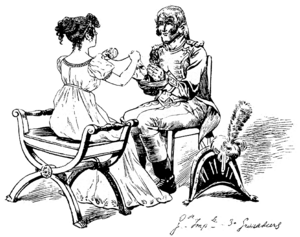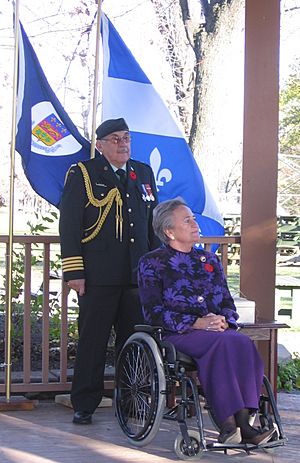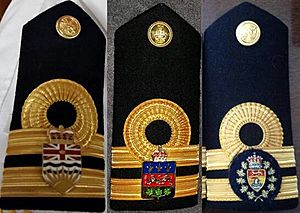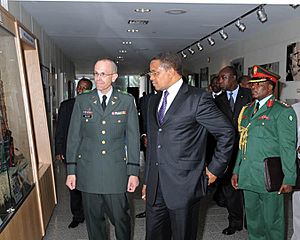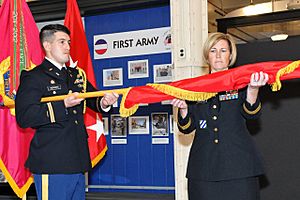Aide-de-camp facts for kids
An aide-de-camp (pronounced "aid-duh-KAMP") is like a special assistant or secretary for important people. These people are usually high-ranking military officers, police chiefs, government leaders, or even members of a royal family or a country's head of state.
Aides-de-camp often help with official events and ceremonies. The main aide-de-camp is usually the most important personal helper. This role is different from an adjutant, who is more like a senior manager for a military group.
A special braided cord called an aiguillette is often worn on the shoulder of their uniform. This cord shows that they are an aide-de-camp. The color and which shoulder it's worn on depend on the rules of that country or organization. In some places, being an aide-de-camp is a special honor, and they can use letters like ADC after their name.
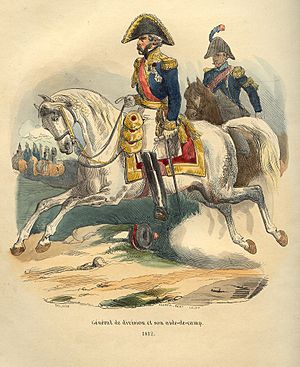
Contents
- Aides-de-Camp Around the World
- Argentina: Helping the President
- Belgium: Assisting the King
- Commonwealth Countries: A Shared Tradition
- Australia: Supporting Governors
- Bermuda: A Tragic Event
- Canada: Aides for Many Leaders
- India: Aides for the President
- Malaysia: From Police and Military
- New Zealand: Helping the Governor-General
- Pakistan: Aides for Top Leaders
- Papua New Guinea: Two Full-Time Aides
- Singapore: From Three Forces
- Sri Lanka: A Long Tradition
- Tanzania: A Colonel for the President
- United Kingdom: Historic and Modern Roles
- France: Helping the President with Important Tasks
- Greece: For the President
- Hong Kong: For the Chief Executive
- Imperial Russia: Aides to the Emperor
- Indonesia: Presidential Adjutants
- Ireland: Assisting the President
- Japan: Imperial Aides
- Portugal: Presidential Military Household
- Thailand: Royal Service Agency
- United States: Aides for Top Officials
- Variations of the Role
- See also
Aides-de-Camp Around the World
Aides-de-camp serve in many countries, often helping top leaders and military officers. Here's how the role works in different places.
Argentina: Helping the President
In Argentina, three officers (one from the army, navy, and air force) work as aides-de-camp for the president. Three more help the Minister of Defense. These six are the only ones called edecán, which is the local word for aide-de-camp.
In 2006, there was a small discussion when President Néstor Kirchner promoted his army aide-de-camp faster than usual. Later, President Cristina Kirchner chose female officers to be her aides-de-camp for the first time.
Aides-de-camp and other assistants in Argentina wear an aiguillette on their right shoulder. Its color shows the rank of the person they serve.
Belgium: Assisting the King
In Belgium, the Head of the King's Military Household is a top general. This person helps the King with defense matters and keeps him updated on the Belgian Armed Forces.
The Aides de Camp to the King are senior officers chosen by the King. They go with important visitors or represent the King when he can't be there himself.
The Equerries to the King are always available to help the King with his daily tasks and travels. Sometimes, people are given the honorary title of aide-de-camp to the King for their special service.
In countries that are part of the Commonwealth (like Australia, Canada, India, and the UK), aides-de-camp usually come from the military. They can use the letters ADC after their names. They also wear the special aiguillette on their uniform.
Australia: Supporting Governors
Australian military officers serve as aides-de-camp to the monarch, the governor-general, and state governors. They also help other senior military leaders. Honorary aides-de-camp to the governor-general can use "ADC" after their names. In the navy, an aide-de-camp is called a "flag lieutenant."
Bermuda: A Tragic Event
In 1973, the governor of Bermuda, Sir Richard Sharples, and his aide-de-camp, Captain Hugh Sayers, were sadly killed at Government House.
Canada: Aides for Many Leaders
In Canada, aides-de-camp are appointed to the monarch, the governor general, and lieutenant governors. They also assist other important officials like the Minister of National Defence.
Many aides-de-camp wear a gold aiguillette when working. They also wear a special symbol of the person they serve. For example, aides-de-camp to the governor general wear the Canadian coat of arms. They are usually officers from the Canadian Forces. Aides-de-camp to lieutenant governors can also come from the police or emergency services.
Aides-de-camp to royal and vice-regal people wear the aiguillette on their right shoulder. Others wear it on their left shoulder.
India: Aides for the President

In India, high-ranking officers (like major generals) have aides-de-camp. It's considered an honor to be an aide-de-camp in India, and they can use "ADC" after their names.
The heads of the army, navy, and air force usually have three aides-de-camp. The president of India has five aides-de-camp (three from the army, one from the navy, and one from the air force). State governors also have two aides-de-camp.
Malaysia: From Police and Military
In Malaysia, an aide-de-camp (called adikung) is chosen from officers in the Royal Malaysian Police or the Malaysian Armed Forces. Sometimes, non-military or police officers are also appointed.
New Zealand: Helping the Governor-General
In New Zealand, military personnel serve as aides-de-camp to royal and vice-regal people. The governor-general has two full-time aides-de-camp. They wear aiguillettes on their right shoulder. Other military assistants wear different aiguillettes on their left shoulder.
Pakistan: Aides for Top Leaders
In Pakistan, the president, prime minister, and governors have their own aides-de-camp. These aides can be from any of the three armed forces and are usually captains or lieutenants. The heads of the military services also have aides-de-camp.
Papua New Guinea: Two Full-Time Aides
The governor-general of Papua New Guinea has two full-time aides-de-camp. One is from the Papua New Guinea Defence Force and the other from the Royal Papua New Guinea Constabulary (police).
Singapore: From Three Forces
In Singapore, the president appoints aides-de-camp from the Singapore Armed Forces (SAF), the Singapore Police Force (SPF), and the Singapore Civil Defence Force (SCDF). Both male and female officers can serve.
Their job is to help with important guests and take care of visiting foreign leaders.
Sri Lanka: A Long Tradition
In Sri Lanka, the president has an aide-de-camp and an extra aide-de-camp from the armed services. All generals and admirals also have an aide-de-camp. In the navy, they are called flag lieutenants.
This tradition goes back to the time of British rule. In 1992, two Sri Lankan aides-de-camp were killed while on duty, and in 2006, one was seriously injured.
Tanzania: A Colonel for the President
The president of Tanzania has an aide-de-camp from the Tanzania People's Defence Force, usually with the rank of colonel.
United Kingdom: Historic and Modern Roles
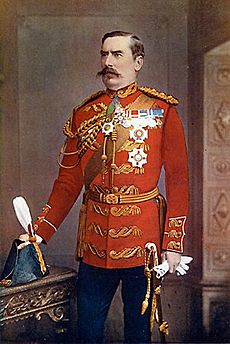
Historically, an aide-de-camp (ADC) was a trusted officer who helped a general. On the battlefield, they delivered orders. In peacetime, they helped with the general's household and social events. In the navy, a "flag lieutenant" did similar duties.
In the past, generals had a certain number of aides-de-camp based on their rank. The monarch could appoint many aides-de-camp, often as an honor for distinguished service. These appointments sometimes came with a promotion. Aides-de-camp used to wear very fancy uniforms, but this mostly stopped after World War I.
Present Day in the UK
Today, in the British Army and RAF, a junior officer might be an aide-de-camp to a senior officer. The navy equivalent is a flag lieutenant. The monarch also appoints a fixed number of senior officers as aides-de-camp, who can use "ADC" after their names. These officers are usually brigadiers or colonels. They don't often have daily duties but participate in important ceremonies like coronations.
Aides-de-camp and other special officers wear aiguillettes on their uniforms. These cords vary in size, color, and position. Aides-de-camp to the monarch also wear the monarch's special symbol on their shoulders.
France: Helping the President with Important Tasks
The president of France, as the leader of the French Armed Forces, has aides-de-camp. There are usually three, including one from the army. Their very important job is to carry the briefcase that allows the use of nuclear weapons. They also help the president with general tasks, like setting up speeches or holding cue cards.
When the president travels, an aide-de-camp often rides in the front seat of the presidential car. They are among the people closest to the president.
Greece: For the President
The President of the Hellenic Republic has aides-de-camp from the Hellenic Air Force, Hellenic Navy, and Hellenic Army.
Hong Kong: For the Chief Executive
Various uniformed services in Hong Kong, like the Police Force and Fire Services, each send an aide-de-camp to the territory's chief executive. This role replaced the governor's aide-de-camp after British rule ended in 1997.
Imperial Russia: Aides to the Emperor
In the 1700s, under Catherine the Great of Russia, her favorite people were often made her aides-de-camp. During World War I, distinguished officers were appointed as the Emperor's aide-de-camp on a rotating basis.
Indonesia: Presidential Adjutants
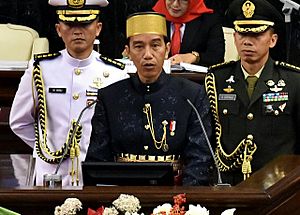
In Indonesia, an aide-de-camp (called Ajudan Presiden) helps the president and vice president. These officers are usually colonels from the military or police. They help with daily tasks and support the president and vice president, and their spouses. They are recognized by their golden aiguillettes.
Other important government officials in Indonesia also have aides-de-camp, who are usually junior officers.
Ireland: Assisting the President
The president of Ireland is the supreme commander of the Irish Defence Forces. Aides-de-camp help the president with daily duties, accompany them to official events, and represent the president at funerals. An aide-de-camp is on duty 24/7 at the president's residence.
Michael Collins was an aide-de-camp during the Easter Rising in 1916.
Japan: Imperial Aides
From 1896 until the end of World War II, the emperors of Japan had army and naval aides-de-camp.
Portugal: Presidential Military Household
The president of Portugal, as the leader of the armed forces, has three aides-de-camp: one from the army, one from the navy, and one from the air force. They are part of the Presidential Military Household.
Portuguese aides-de-camp serve for a maximum of five years. They help the president with journeys, ceremonies, and receiving important visitors. They also assist foreign leaders visiting Portugal and help with military ceremonies.
Thailand: Royal Service Agency
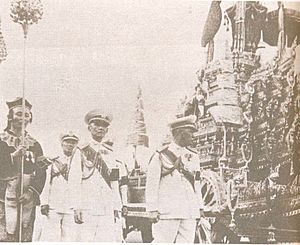
The Royal Thai Aide-De-Camp Department is a royal agency. It organizes royal appearances and keeps the Thai royal family safe. Aides-de-camp are also appointed to senior officers in the Thai Army, Navy, and Air Force. King Chulalongkorn started the Royal Guard in 1870, and Lieutenant General Prince Suksvasti is considered the first Thai aide-de-camp.
United States: Aides for Top Officials
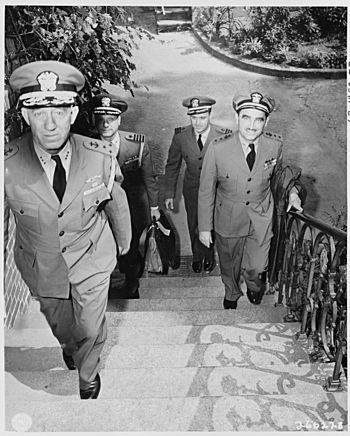
Military officers serve as aides to the Secretary of the Army, Secretary of Defense, Vice President, and president of the United States. If an official has more than one aide, the senior aide usually manages the others.
The president has six military aides, one from each armed service. These aides are usually majors or lieutenant colonels. One of their most important jobs is to carry the presidential nuclear football (a briefcase with nuclear launch codes). There are also many part-time "military social aides" who help with White House social events.
In the United States Army, aides-de-camp are specifically appointed to generals. They usually serve for up to two years. A general can choose an officer of a certain rank to be their aide-de-camp, depending on the general's own rank. For example:
- A brigadier general (one-star) can have a first lieutenant.
- A major general (two-star) can have a captain.
- A lieutenant general (three-star) can have a major.
- A general (four-star) can have a lieutenant colonel.
Aides-de-camp in the U.S. Army wear a special symbol on their uniform lapels instead of their usual branch insignia. This symbol shows the rank of the general they serve. They also wear a special aiguillette on their dress uniform.
-
Insignia for an aide to a general of the army.
In the United States Navy, an aide-de-camp to an admiral is also called a "flag aide" or "flag lieutenant."
The highest honor in the U.S. state of Tennessee is "Colonel Aide de Camp." These colonels serve as personal aides-de-camp to the governor of Tennessee.
Variations of the Role
- Air aide-de-camp
- First and principal naval aide-de-camp
- Flag aide-de-camp
- Naval aide-de-camp
- Aide-de-camp general
- Aide-de-camp to the emperor of Japan
- Aide-de-camp extraordinary
- Executive aide-de-camp
- General's enlisted aide
See also
 In Spanish: Ayudante de campo (milicia) para niños
In Spanish: Ayudante de campo (milicia) para niños
- Batman, a similar role for lesser officers
- Equerry, an attendant who historically held responsibilities for the horses of an officer
- Adjutant, a military appointment who assists the commanding officer with unit administration
- Body man, for modern politicians
- Attaché, a similar role in diplomacy
- Bernard Schriever, a former aide-de-camp and pilot who was a founder of the US Space Force


